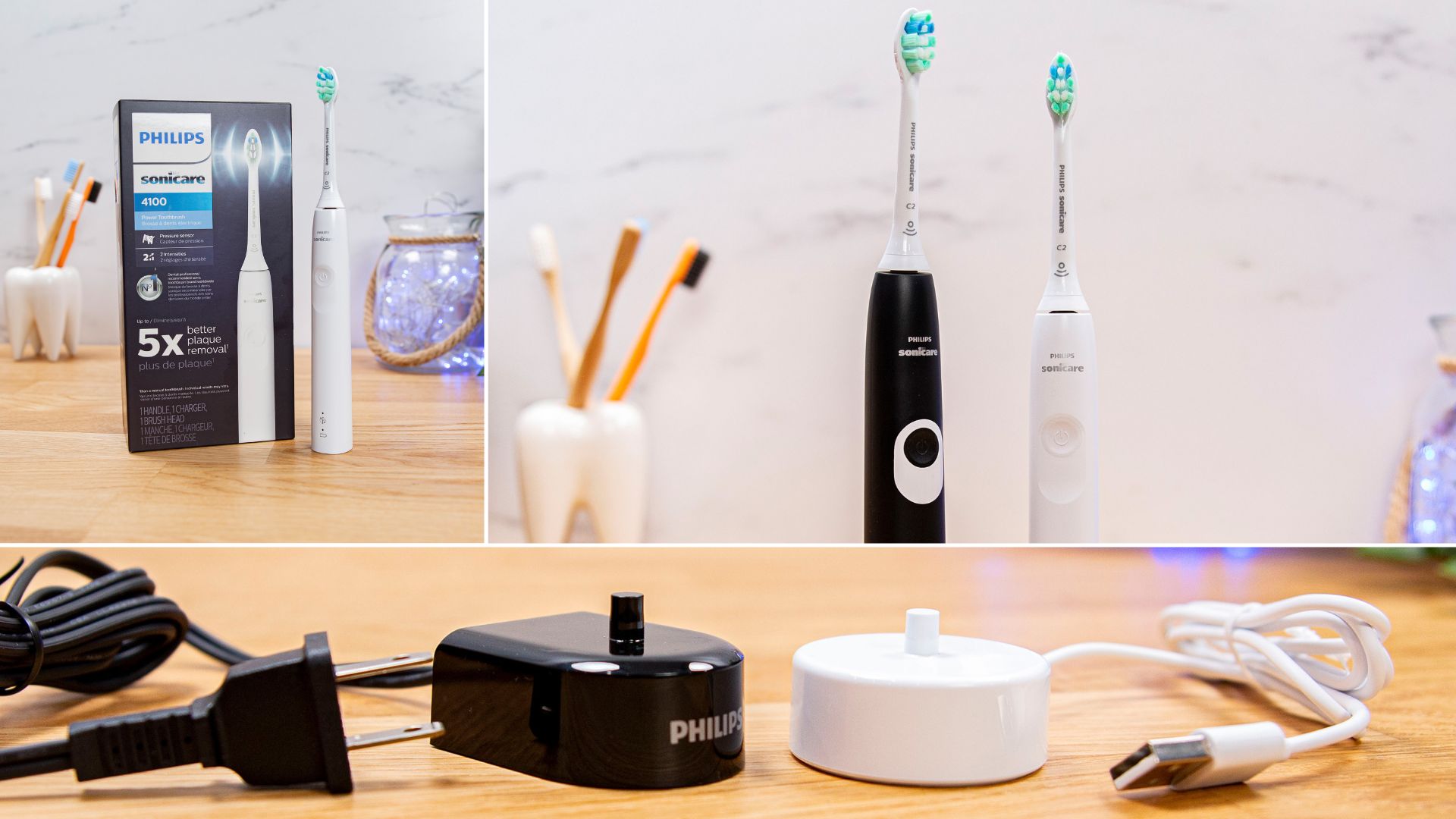
Our choice: 4100 Series
Technically, it is the ProtectiveClean 4100 that is the better choice.
It has a longer battery life and more bristle movements per minute.
But, in reality, the differences are not that significant. The slimmer handle and multiple brushing intensities of the 4100 Series are very appealing.
The ProtectiveClean 4100 is being phased out by Philips. The 4100 Series is the replacement. Buying the ProtectiveClean will soon be very difficult, making the 4100 Series your only option.

Key differences
| Find out more |
| Electric Teeth Rating |
| Retail price |
| Approximate 3 year cost |
| Cleaning Action |
| Number of cleaning modes |
| Brushing intensities |
| Timer |
| Pacer |
| Pressure Sensor |
| Battery life |
| Battery type |
| Number of heads included |
| Travel case included |
| Bluetooth connectivity |
| Position tracking |
| Noise |
| Warranty |
| Buying options |
|
Our Choice

|

|
|---|---|
| Review | Review |
|
(4.9)
|
(4.9)
|
| $50 | $70 |
| $150 | $160 |
| Sonic | Sonic |
| 1 | 1 |
| 2 | - |
|
|
|
| 30 second quadpacer | 30 second quadpacer |
|
|
|
| 14 days | 14 days |
| Rechargeable Lithium-Ion (Li-Ion) | Rechargeable Lithium-Ion (Li-Ion) |
| 1 | 1 |
| - | - |
| - | - |
| - | - |
| 60dB | 52dB |
| 2 years | 2 years |
- Cleaning/brushing action
- The ProtectiveClean offers 62,000 movements per minute compared to the 31,000 of the 4100 Series.
- Handle design/colors
- The 4100 Series handle is slimmer and lighter.
- The 4100 Series is available in 6 color options compared to the 5 of the ProtectiveClean.
- Cleaning modes
- The 4100 Series offers 2 brushing intensities the ProtectiveClean doesn’t.
- Battery
- The ProtectiveClean achieved 5 weeks compared to the 17 days of the 4100 Series.
- Accessories & box contents
- The 4100 Series has a USB charging stand rather than the 2 pin charger of the ProtectiveClean.
- Price
- The 4100 Series is cheaper at $49.96 versus the $69.99 of the ProtectiveClean.
Please note. Every effort is made to ensure the key differences listed are correct, but these differences are subject to change without notice. Products and the box contents can be changed without notice and different variants can exist.
Detailed comparison: what’s the difference between the 4100 Series and 4100 ProtectiveClean?
Whilst there are a few differences between these models, they are in all honesty more similar than they are different.
Both have a 2 minute timer, 30 second pacer, built-in rechargeable battery, brush head replacement reminder technology, a pressure sensor and water resistance.
The differences that do exist for most users are not really that significant.
Consider also that in time the ProtectiveClean will cease to be available, as the 4100 Series is the replacement for this model.
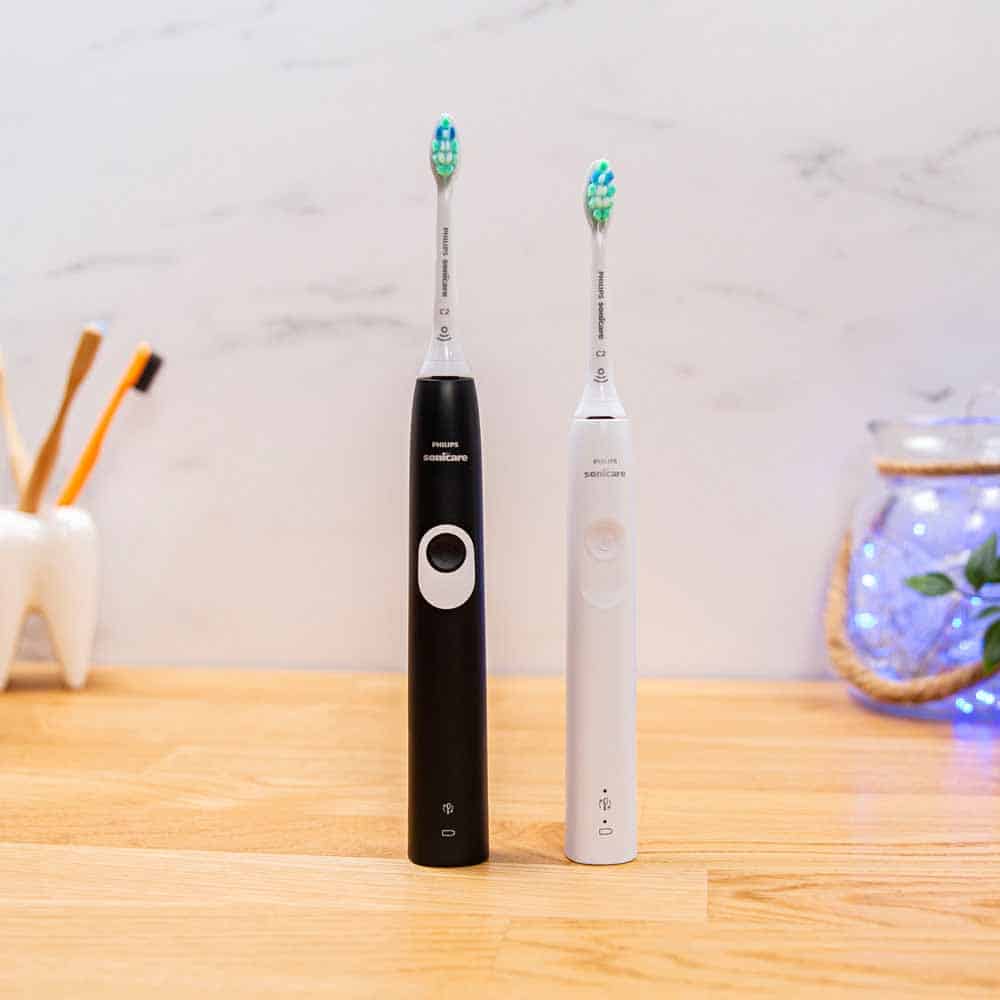
Arguably the most significant difference between these 2 sonic toothbrushes is the motor and the number of bristle movements they offer.
For quite some time, Sonicare has promoted how most of its toothbrushes benefit from 62,000 movements.
This figure is quoted within the specification pages of most of their power toothbrushes.
However, more recently Sonicare is not disclosing the number of movements within the technical specification of newer models, the 4100 Series included.
I am not sure what the ‘official’ explanation is as to why, but I suspect it has something to with the fact, that to most people it is a relatively meaningless number.
But, to those familiar with this, it is a guide. Seeing as the new 4100 Series offers only 31,000, it might seem like you are not getting the ultimate Sonicare experience from this newer model.
Yet, in daily use, it doesn’t play out quite as you might expect. I explain why in the next section ‘Does one clean better than the other’.
The 4100 Series is slimmer and lighter than the ProetectiveClean 4100.
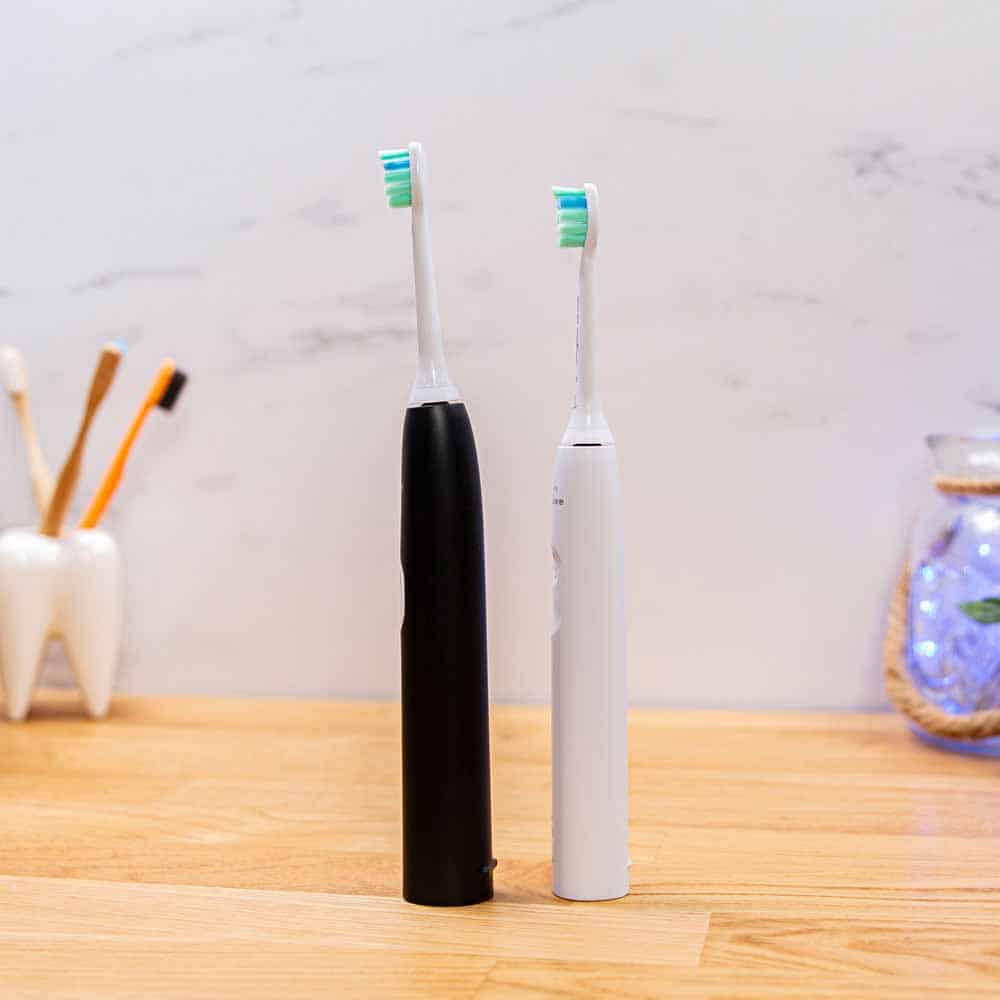
The difference in width and depth of the handle is minimal, although noticeable in the hand.
The 4100 Series does feel lovely and slim. Although it still feels durable, the extra size and weight of the ProtectiveClean gives the impression at least of being the more durable toothbrush. This is likely more psychological than anything.
But it is the difference in handle weight that is most significant. 1.2 ounces has been cut from the weight of the newer 4100.
The ProtectiveClean measures in at:
- Height (without head) – 19cm/7.4 inches
- Height (with head) – 25cm/9.8 inches
- Width – 2.8cm/1.1 inches
- Thickness – 3cm/1.1 inches
- Weight (without head) – 125g/4.4oz
- Weight (with head) – 130g/4.6oz
The 4100 Series measures and weighs:
- Height (without head) – 17.3cm/6.8 inches
- Height (with head) – 23.4cm/9.2 inches
- Width – 2.5cm/0.9 inches
- Thickness – 2.7cm/1 inches
- Weight (without head) – 92g/3.2oz
- Weight (with head) – 97g/3.4oz
From a design point of view, they are very similar. Both have a clean and minimal look to them. Both brushes have limited gripping points and textured surfaces which means they are easy to keep clean.
Both models are available in 6 different color options, the choices for each are different.
4100 Series:
- Sugar rose
- White
- Black
- Deep pink
- Azure blue
- Dark forest
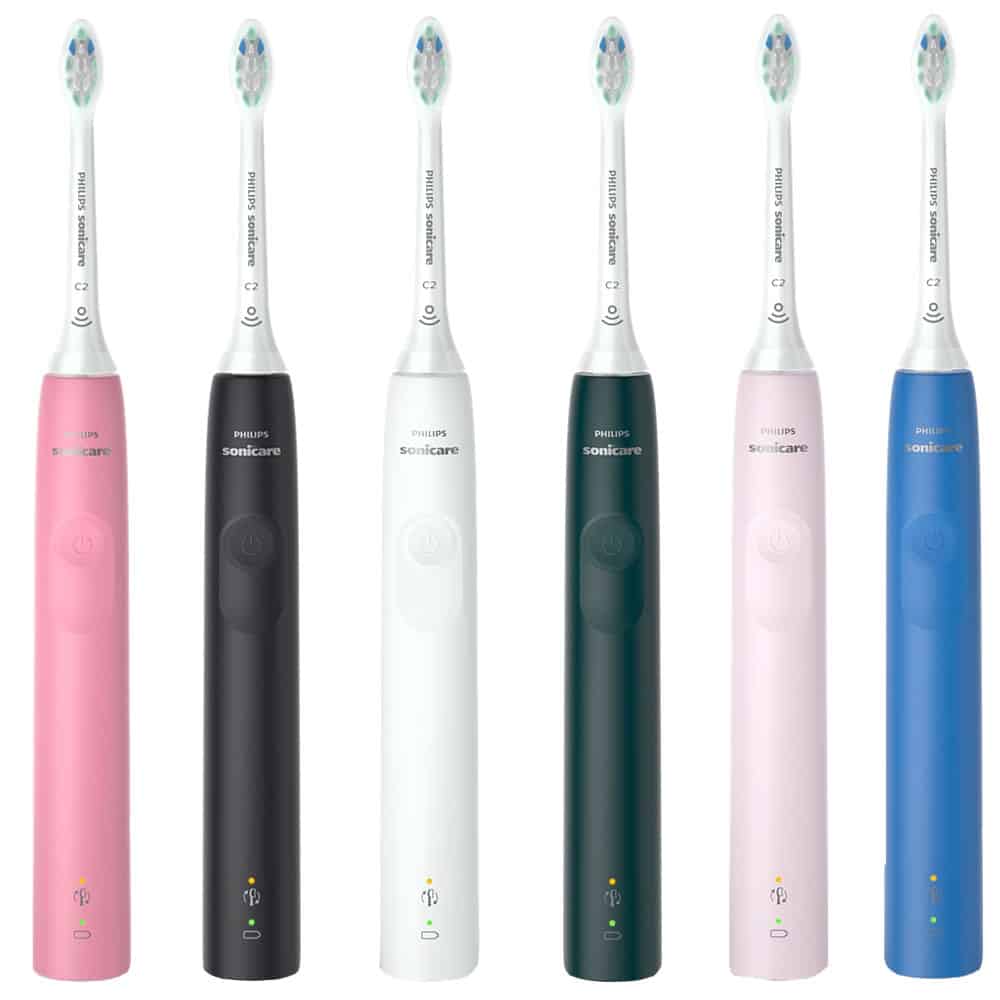
4100 ProtectiveClean:
- Navy blue
- Pastel pink
- Black and white
- White and mint
- Turquoise
In many cases the power button is colored to accent the brush handle.
Brush heads and accessories tend to be white in color.
The older ProtectiveClean offers just 1 cleaning mode and no option to change the brushing intensity.
The 4100 Series on the other hand has 2 brushing intensities. There is a high and a low mode.
High uses the full power of the motor, whilst the low mode, feels like it is using about half the power of the high mode.
Best brushing results will be achieved from the high mode, but having a softer and more gentle low mode is beneficial for first time electric toothbrush users, and those with some sensitivity or tenderness in their teeth and gums.

Both brushes have a rechargeable Lithium-Ion battery built in. With both, Sonicare claims a battery life of 2 weeks. As you might expect both achieve this and then some.
The ProtectiveClean in our hands-on testing lasted 5 weeks on a full charge. That is over 2 and a half times the claimed life.
The 4100 Series on the other hand achieve just 17 days when set to the highest intensity.
But, when set to low intensity setting it achieved over 5 weeks.
I suspect the capacity of the batteries might be different given the slimmer handle of the 4000 Series.
Within the base of the brush handle is a recess into which the pin on the top of the charging stand fits.
Charging wirelessly, both brushes come with the stand included, but the 4100 Series has a newer designed stand that has a USB connector as opposed to the 2 pin power adapter of the ProtectiveClean.
The 4100 Series does not come with a USB to 2 pin plug adapter. You will need to source one of these if you don’t already own one.
The ProtectiveClean can not be connected to a USB port with its charger.
There is too a slight difference in the overall size of the charging stand. The new USB charger is a little wider and circular compared to the more oval shape of the ProtectiveCleans stand. The newer charger isn’t quite as thick either.
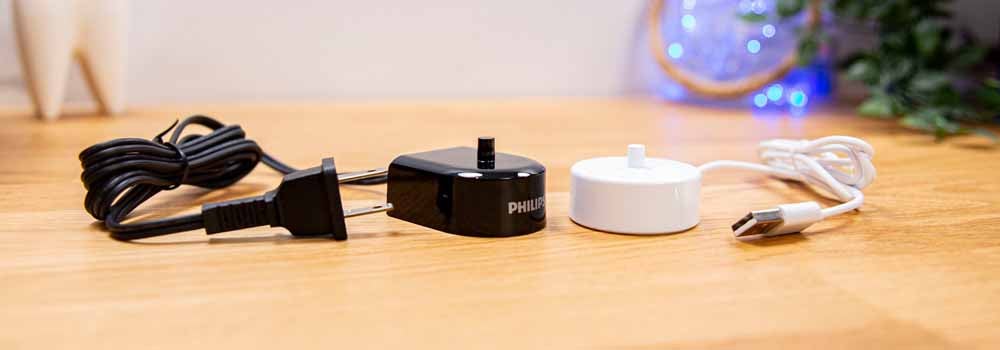
Does one clean better than the other?
The short answer is no.
Use either of these brushes twice a day, for 2 minutes each time, along with the correct brushing technique and you are going to get very good cleaning results.
However, technically there is a difference between these 2 models that could result in differences long term.
The older ProtectiveClean 4100 offers 62,000 movements per minute. This is otherwise referred to as 31,000 brush strokes.
The newer 4100 Series offers half that at 31,000 movements per minute. Or, 15,500 brush strokes.
Based on the numbers alone, this seems relatively significant.
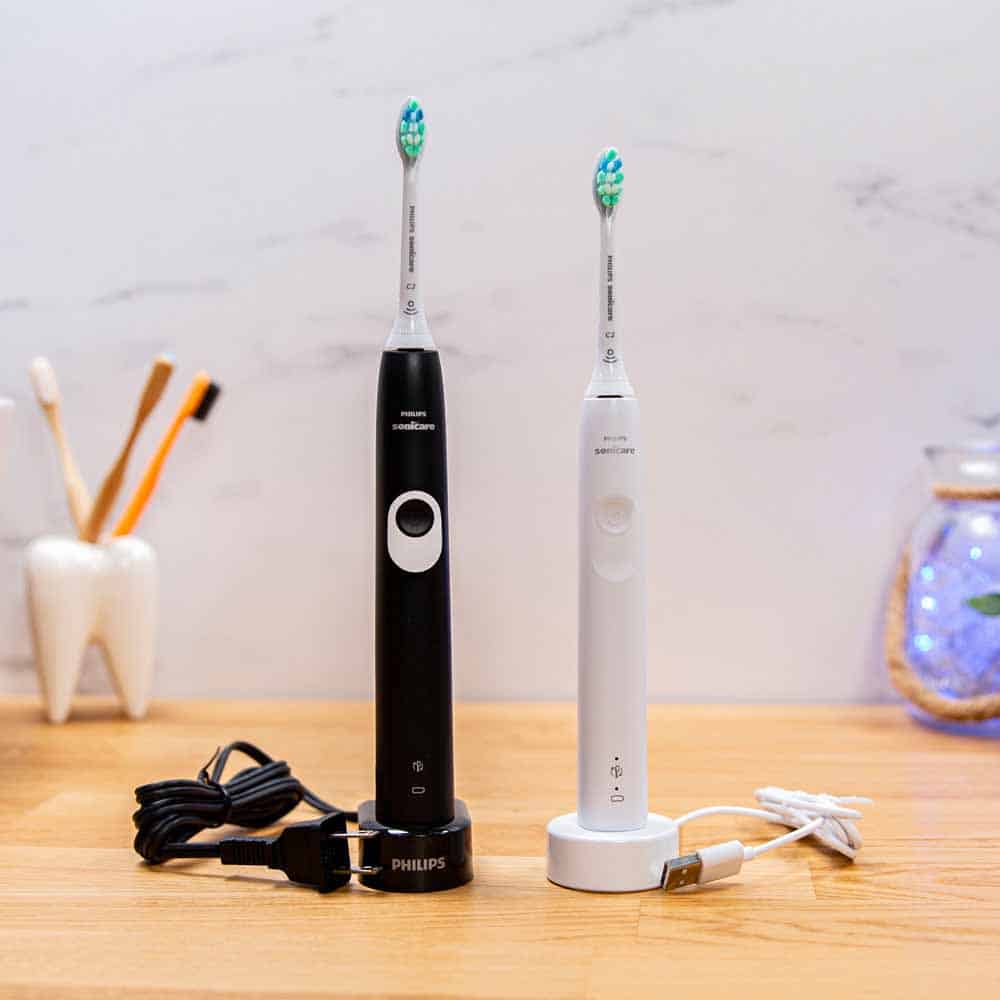
I do believe the logic of more movements equalling a better clean, is correct to some extent.
Yet, in everyday use, this doesn’t translate in quite the way you would expect.
In my (at home) plaque disclosing tests, both brushes performed comparably.
If I were to use these 2 brushes when I was blindfolded, it would be difficult for me to really say which is which.
This is because the 4100 Series brush motor has been tuned to offer a higher amplitude.
What this means is that the distance that the bristles cover and the angle of the sweeping action is greater. When using the brush, it feels really quite powerful and the resulting clean of the teeth is very satisfying.
There are other brushes within the Sonicare range that also offer 31,000 movements but don’t have the amplitude configured like the 4000 Series. The difference in the intensity and power of the bristles against the teeth and gums is noticeable. Although satisfactory, they feel weaker and you don’t get the same post brushing feeling.
This comparison isn’t a clinical or scientific study, so I can’t conclusively say what the impact is over many months of use.
If you used both brushes perfectly for 2 minutes twice a day, the ProtectiveClean might result in increased plaque removal.
The difference is unlikely to be that much better that it would make clinically significant improvements to your oral health.
Although, this assumes using the high intensity on the 4000 Series. Using the low intensity would likely produce different results.
With so many variables, only a clinical trial would highlight if one really performs that much better.
I suspect Philips made this decision for a reason and if the additional movements were so important, they would have configured the 4100 Series accordingly.
As it stands, dentists confirm that few people are brushing with the correct technique, for the right time or even for the right number of times today. For most people, perfecting these will have a bigger positive impact on their oral health than the number of bristle movements.
Is one better priced than the other?
Yes, if based on retail prices alone.
The 4100 ProetectiveClean has a retail price of $69.99 compared to the $49.96 of the 4100 Series.
Therefore the newer 410 Series is $20 cheaper.
This is a pretty reasonable price difference given these are not premium toothbrushes.
And, bearing in mind that there have been several years between the launch of these brushes, I would have expected inflation to result in the 4100 Series being priced at least the same as the ProtectiveClean.
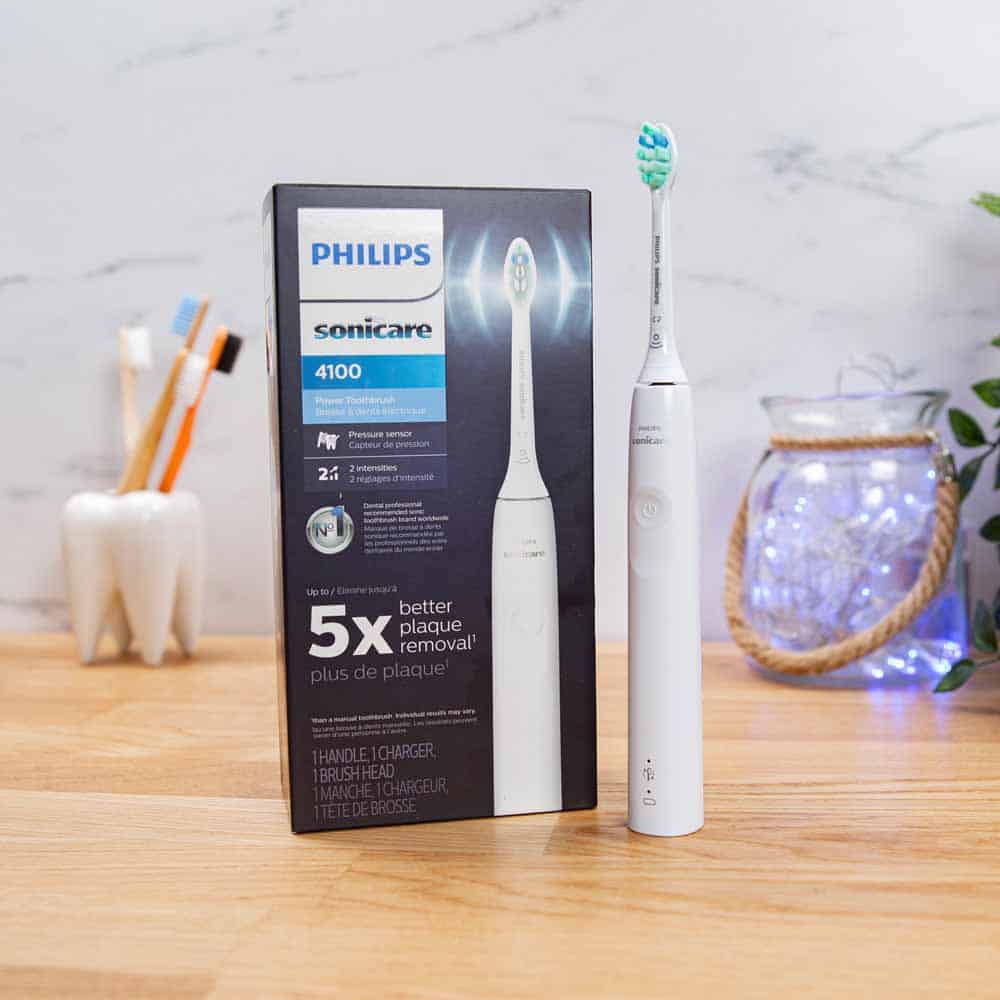
Retail price is one way to compare, but in reality, the selling prices are different.
Prices do vary from one seller to another. And they can change around particular seasons, but as a rough guide, there is a discount of 20% or thereabouts applied to such products.
This means that the 4100 ProtectiveClean actually sells for around $50.
Whilst the 4100 Series should sell for around $40.
Accounting for the discount reduces the retail price difference to just $10.
That said, because of the lower retail price for the 4100 Series, average selling prices have remained higher. It isn’t being sold as low as $40 as often as I would expect.
Either way at $50 both of these brushes is a very good buy.
As both brushes use the BrushSync enabled heads, the ongoing pricing of these models is the same. A smart brush head like this typically works out at around $10 each.
Over 3 years, the 4100 Series works out at around $150 while the ProtectiveClean costs $160.
Conclusion
There really is little difference between these 2 models.
They are more similar than they are different and where one gains, the other has an equal positive element.
The ProtectiveClean is the better toothbrush from a specification point of view, but in reality, it doesn’t quite play out quite how some might expect.
It is the 4100 Series that is our recommended brush, as it is the replacement for the ProtectiveClean.




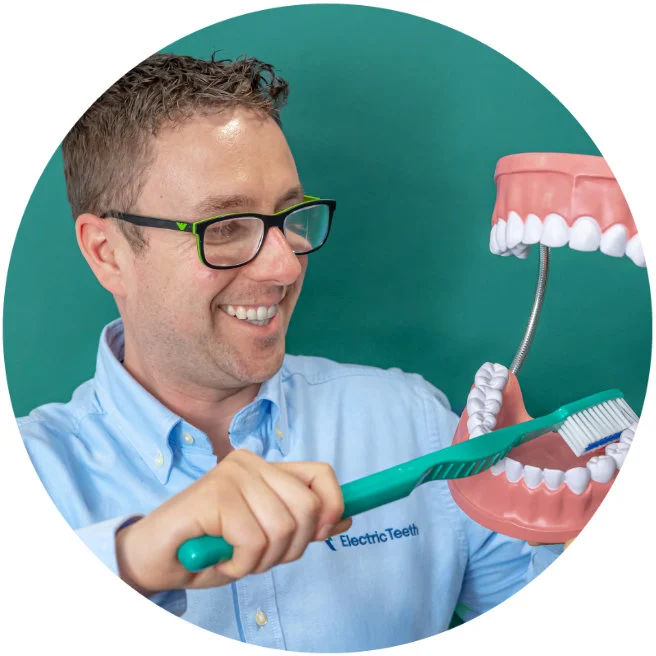
Just a tip ... Since they're discontinuing the older model it's price has been reduced at some retailers. I picked up the Protective Clean 4100 for about $33 including tax at Best Buy. Not sure what the price is now, but certainly seems like the better way to go while they're still available!
"The ProtectiveClean offers 62,000 movements per minute compared to the 31,000 of the 4100 Series." But doesn't the current 4100 series have 2 intensity settings, 31,000 and 62,000, so it could be set to 62,000, making it comparable? I have an old 4100 from years ago that may be starting to go but don't want to get one that is noticeably less powerful, as some have said. Thanks
The 4100 Series has 2 iintensity settings, but they are not configured to 31,000 and 62,000 as suggested.
Philips don't specify exactly how they differ unfortunately.
If the 4100 protective clean is the best over the other 4100 and the and the oscillation or the movement of the brushes are twice as much which should I buy? and why is Philips discontinuing the seemingly better one?
In an ideal scenario, the ProtectiveClean 4100 would be the one to buy, but this is harder to obtain at sensible prices today as it has been replaced with the 4100 Series.
I don't know the exact reasons for as to why they have decided to replace the ProtectiveClean with the 4100 Series but I suspect it has something to do with the manufacturing arrangements they have and is alinged with a more recent refresh in models on offer.
The 4100 Series is still very good, just there are notable differences between the 2, had you been an existing owner of the 4100 ProtectiveClean for example.
Thank you so much for this. This was so in depth and this confirmed I wasn't crazy. I literally just replaced my old protective clean, with the new version of the 4100. "Why the hell would they have changed it at all?" Is what I thought. I mean it's the same model and all.
When I used the new 4100 right out of the box I immediately noticed a difference at how much weaker it was. I was absolutely pissed off. First of all they packaged it with the C2 brush heads which feel way too weak. So I popped on one of my c3s from the old one and it helped a bit But still noticeably weaker.
100% I guarantee they just reduced the battery size and power to save costs. This thing was a huge bait and switch and I'm kind of done with sonicare now. Who knows, maybe there is some science behind having less brushstrokes but if that was the case, then they would have put that in the brochure or part of its marketing. They did not.
Half the brush strokes. I feel like I didn't even brush my teeth at all.
Have you find out that the new 4100 can operate at 2 intensities and that the low intensity mode is its default (e.g. you always have to switch it to the high mode)? I've seen several people complaining about the weakness of this new 4100 before they discovered that they were using it at the low intensity mode.
Very strange that the claim for ProtectiveClean 4100 vs 4100 wasn't called out in this article. Why is that?
ProtectiveClean 4100's "Removes 7x more plaque than manual toothbrush", vs 4100 "Up to 5x better plaque removal than a manual toothbrush", appears to be superior and more compelling to a user on shopping the isle.
Indeed I do agree. However, getting these results relies on some very specific variables.
I am not sure of the exact studies that gained the 5 or 7 times claims Sonicare site. It is not known if the exact same approach was taken in each study etc.
We don't make a big thing of it because different brushing styles, cleaning modes/intensities, brush head style etc all have a bearing on the results.
For 'most' people 5x more plaque removal is going to be considerably better. The marginal extra will unlikely have significant bearing on a persons overall dental health.
My ProtectiveClean 4100 broke and I bought the 4100 series, not knowing it would be different. I'm glad to hear your findings, but I still feel like they should have left well enough alone. I also noticed that the ProtectiveClean was made in Indonesia and the new 4100 series is made in China, for whatever that's worth. I'm using my old charger with the new brush. Hopefully no problems from doing that.
That's really funny that you noticed that they are manufactured in different areas. Coincidentally the new one feels cheap as hell and underpowered. I'll probably be switching to a new brand next time.